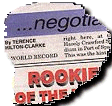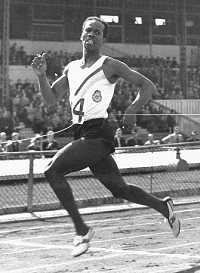

This year will mark the golden jubilee of the 1948 Olympic Games in London. It was there that Trinidad and Tobago competed in the globe's biggest sporting event for the first time. The initial team included weightlifter, Rodney Wilkes, who went on to win this country's first medal - silver in the featherweight class - along with a track and field team composed of sprinter George Lewis and long-distance runner Mannie Ramjohn.
But there was another Trinidadian sprinter in London: competing for Great Britain -- which was not uncommon, given that his country was still a part of the British Empire. The man in question was Emmanuel McDonald Bailey, a 27-year old who was in the midst of establishing a world record for a number of national titles won at the British AAA Championships (15, 1946-53).
In addition to placing 4th in the 100 metres in London, Bailey would go on to earn a bronze four years later at the Helsinki Olympics. But, the zenith of his career came at Belgrade, Yugoslavia in 1951 when he clocked 10.2 to become the only Trinidad-born athlete to hold a world record in an individual athletic discipline.It was a feat which ranked Bailey among the finest track athletes produced by this country: Mannie Dookie,JRN Cumberbatch, George Lewis, Michael Agostini, Edwin Roberts, Wendell Mottley, Hasely Crawford, Michael Paul and Ian Morris.1949: Bailey looks back to see Herb McKenley in his wake, while winning a race at White City Stadium. That day, Bailey's three-year old son, Robert, had been carried to the hospital with suspected meningitis. The sprinter's worry had been aggravated by McKenley's pre-race psychological tactics. Bailey "ran like a deer" to leave the great Jamaican trailing behind.
With Ato Boldon's progressive strides toward joining these elite ranks, and his continuing quest for a world record in the 100m, it is only fair that we not forget the one who put Trinidad and Tobago on the athletics map.
McDonald Bailey was born in the Hardbargain section of Williamsville, south Trinidad, on December 8, 1920, and realised his athletic prowess at an early age. He was sprint champion at his Arima primary school - Arima Boys Government School - as well as his secondary schools: Tranquility Boys Intermediate and Queen's Royal College in Port of Spain.In 1935, Bailey was invited to compete in a meet in St Vincent where he broke the local record. Two years later, the precocious 16-year old became the first local sprinter to beat JRN Cumberbatch over 220 yards in the then national record time of 21.5. He then went on to take part in the British AAA Championships, in London, reaching the second round of the 220 yds. After becoming Trinidad and Tobago national sprint champion, Bailey returned to England in 1944 as part of service in the Royal Air Force (RAF). The following year, he was invited to represent Great Britain in the dual meet versus France, after running second to Empire Games sprint champion, Cyril Holmes, throughout the 1945 season. It was during the next eight years, that Bailey established his world record for most national titles, winning the sprint double every year - except 1948, due to the fact that he suffered a serious injury to his left leg at the end of 1947.
While trying to regain fitness, he competed at the '48 AAA Championships where he was beaten by an Englishman - Alistair McCorquodale - for the first time, and lost to John Treloar in the final. Nevertheless, he went on to win both 100 and 200 after that, and added a relay title to make it 15 in all. Apart from the world record established in Belgrade, Bailey also held the British 100 yds (9.6) and European 100 metres (10.2) records between 1946 and 1953. Noted for his disciplined training regimen, Bailey had been likened to the Greek athletes of 3,000 years ago by Philip Noel-Baker who stated: "No modern sprinter has ever fulfilled the Greek ideal more perfectly than E. McDonald Bailey. In his training he has been a model of perseverance, self-discipline, and concentration for many years. In his races he has shown a grace of movement, a perfection of style, that no other sprinter has ever surpassed."
In a 1958 ranking of the world's 100 greatest sprinters, Bailey was placed 21st on a list which includes such sprinting greats as Bobby Morrow (No.1), Jesse Owens, Mel Patton, Hec Hogan, Jackson Sholtz and Art Bragg. Fellow Trinidadian, Mike Agostini (51st), and Jamaican legend, Herb McKenley (59th) also figured in the ranking. Because of his success in England, Bailey was invited to represent Trinidad and Tobago in the inaugural Central American and Caribbean (CAC) Games in Baranquilla, Colombia in 1946, where he captained the team. However, there was uncertainty on the part of the Trinidad and Tobago Olympic Association (TTOA) whether or not to compete in London. There was a shortage of funds - George Lewis had to get funding in order to compete. Furthermore, there were the doubts concerning Bailey's fitness in light of his injury. As Bailey admitted this week: "I was written off by the experts." It had even been alleged that TTOA president Sir Lennox Riley, concerned about Bailey's form, actually requested that the athlete not be included on the local team. In any case, Bailey's father, then a member of the TTOA wrote his son advising him to compete for Great Britain in light of the indecision at home. It was on this basis, according to Bailey, that: "I accepted Britain's rather tongue-in-cheek invitation to run in the 100 metres."
Things were not certain on the other side of the Atlantic either. The British federation left open the possibility for Bailey to be made available to compete for his homeland. But the meeting with the Trinidad and Tobago delegation lasted all of three minutes with the local chef-de-mission, Knowles, brusquely declaring: "We have not made any provisions for Bailey." In light of the injury, it was a miracle that Bailey made it to the final where he finished fourth. Four years later in Helsinki, Bailey figured in a dramatic 100 metres final in which four sprinters, including himself, were credited with a time of 10.4. Photo-finish technology was utilized and, in the end, Bailey was given a third-place finish, and the bronze medal. Bailey's route to the world record had an interesting twist - he had actually achieved it two years earlier in 1949. Running in perfect conditions at a meet in Reijkjavik, Iceland, Bailey crossed the line in 10.2. But, red-faced organizers would have to come to terms with the absence of a wind gauge in the stadium, a stipulation already of the IAAF: the "record" could not be ratified. Nevertheless, Bailey took advantage of similar conditions in Belgrade to achieve the clocking once again.After retiring from the track in 1953, McDonald Bailey dabbled in professional rugby in England for one season, before displaying his journalistic calling. An associate member of the London Institute of Journalists, he worked for the BBC at the 1960 Olympic Games in Rome, and the 1970 Commonwealth Games in Edinburgh. Over a period of 30 years, he has written for various publications in England and Trinidad. During this time, he went to British Guiana where he was employed with the top Guyanese firm, Bookers, from 1954 to 1963. It was here that he introduced the concept of cross country running, as a necessary training regimen for all sports to the region. Long distance jogging is important in all sports as a foundation for all-round fitness. Bailey actually helped to introduce this on the training programme at two English Football League clubs: Queen's Park Rangers and Brentford. Bailey is convinced that it is the lack of such preparation that is affecting some of our sports teams. He singled out the West Indies team, pointing out that "Courtney Walsh can be in the prime of his career at 35, once he keeps himself fit": by contrast, he said that other players may be feeling the effects of strain.Part of Bailey's legacy in Guyana is the country's present renown for long-distance running. He worked closely with top sports personalities such as Joe Solomon, George DePena and Ian McDonald. The locals have not forgotten his work, and on two occasions last year, he was invited back to Guyana where his wisdom was consulted again.On his return to Trinidad in 1963, Bailey worked at both the National Energy Corporation (NEC) as well as the Shell Oil company. But he continued to be involved in athletics and, was the coach of the outstanding Trinidad and Tobago track team which won three medals at the 1964 Olympic Games in Tokyo. Bailey now lives in Port of Spain: renting a room in Woodbrook while still conducting business in downtown, where he contributes articles for the Catholic News publication. In 1977, Bailey was awarded the Chaconia Gold Medal for his contribution to local athletics. However, in light of his all-round achievements, it is still a mystery as to why the local administrative powers - particularly the Ministry of Sport and Youth Affairs - have not made more active use of his wisdom and experience. Why hasn't he, at least, been given access to the schools across the country? In spite of all this, McDonald Bailey's standing as an athletic great remains unfazed. Even today, he receives letters of admiration and was recently presented with a book by British 400m hurdles record holder, Kriss Akabusi. Accolades, in varying degrees, have also been bestowed over the decades. Akabusi told Bailey that he is an "inspiration "; while he has been referred to by track and field statistician, Maxwell Stiles, as "one of the greatest sprinters of all time."
|





